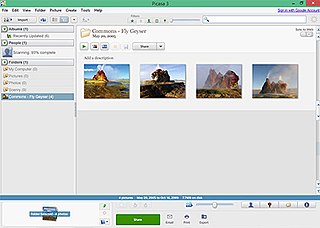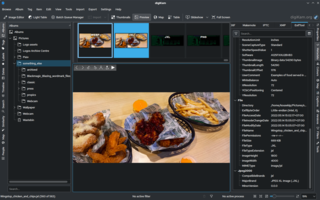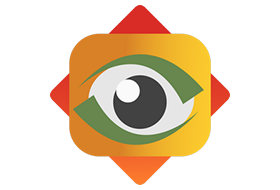A file viewer is a utility application software on operating systems, such as Linux, macOS, or Windows. The file viewer is responsible for user access of files located on a data storage device. File viewers allow the user to open and view content on a device, such as a Personal Computer (PC) or a mobile phone.

Portable Network Graphics is a raster-graphics file format that supports lossless data compression. PNG was developed as an improved, non-patented replacement for Graphics Interchange Format (GIF)—unofficially, the initials PNG stood for the recursive acronym "PNG's not GIF".
CodedColor is a bitmap graphics editor and image organizer for computers running the Microsoft Windows operating system, and is published by 1STEIN.
In computing, an icon is a pictogram or ideogram displayed on a computer screen in order to help the user navigate a computer system. The icon itself is a quickly comprehensible symbol of a software tool, function, or a data file, accessible on the system and is more like a traffic sign than a detailed illustration of the actual entity it represents. It can serve as an electronic hyperlink or file shortcut to access the program or data. The user can activate an icon using a mouse, pointer, finger, or voice commands. Their placement on the screen, also in relation to other icons, may provide further information to the user about their usage. In activating an icon, the user can move directly into and out of the identified function without knowing anything further about the location or requirements of the file or code.

File Explorer, previously known as Windows Explorer, is a file manager application and default desktop environment that is included with releases of the Microsoft Windows operating system from Windows 95 onwards. It provides a graphical user interface for accessing the file systems, as well as user interface elements such as the taskbar and desktop.

Picasa was a cross-platform image organizer and image viewer for organizing and editing digital photos, integrated with a now defunct photo-sharing website, originally created by a company named Lifescape in 2002. "Picasa" is a blend of the name of Spanish painter Pablo Picasso, the word casa and "pic" for pictures.

Microsoft Office Picture Manager is a raster graphics editor introduced in Microsoft Office 2003 and included up to Office 2010. It is the replacement to Microsoft Photo Editor introduced in Office 97 and included up to Office XP.
The following tables compare general and technical information for a number of notable file managers.

Geeqie is a free software image viewer and image organiser program for Unix-like operating systems, which includes Linux-based systems and Apple's OS X. It was first released in March 2010, having been created as a fork of GQview, which appeared to have ceased development. It uses the GTK toolkit. In September 2015, development was moved from SourceForge to GitHub.

ACDSee is an image organizer, viewer, and image editor program for Windows, macOS and iOS, developed by ACD Systems International Inc. ACDSee was originally distributed as a 16-bit application for Windows 3.0 and later supplanted by a 32-bit version for Windows 95. ACDSee Pro 6 adds native 64-bit support. The newest versions of ACDSee incorporate modern Digital Asset Management tools like Face Detection & Facial Recognition.
On Microsoft Windows operating systems, starting with the Internet Explorer 4 Active Desktop Update for Windows 95 to 98, a thumbnail cache is used to store thumbnail images for Windows Explorer's thumbnail view. This speeds up the display of images as these smaller images do not need to be recalculated every time the user views the folder.
Compared with previous versions of Microsoft Windows, features new to Windows Vista are numerous, covering most aspects of the operating system, including additional management features, new aspects of security and safety, new I/O technologies, new networking features, and new technical features. Windows Vista also removed some others.

An image organizer or image management application is application software for organising digital images. It is a kind of desktop organizer software application.

FastStone Image Viewer is an image viewer and organizer software for Microsoft Windows, provided free of charge for personal and educational use. The program also includes basic image editing tools, like cropping, color adjustment and red-eye removal.

FastPictureViewer is a freemium image viewer for Windows XP and later. Its aim is to facilitate quick review, rating and annotation of large quantities of digital images in the early steps of the digital workflow, with an emphasis on simplicity and speed. As an app with a freemium license, a basic version is available cost-free for personal, non-profit or educational uses, while a commercial license is required for the professional version with additional features. The basic version starts as a full version trial.
Some of the new features included in Windows 7 are advancements in touch, speech and handwriting recognition, support for virtual hard disks, support for additional file formats, improved performance on multi-core processors, improved boot performance, and kernel improvements.

Picture Motion Browser (PMB) is a software application from Sony for organizing and editing digital photos. In 2012, PMB was succeeded by Sony's PlayMemories Home.

Double Commander is a dual-pane file manager. It is a free and open-source software licensed under the terms of the GNU General Public License. It is designed to be operated by a keyboard, a mouse, or by both at the same time.
PMView is a raster graphics image viewer, converter, and organizer with basic image editing capabilities. It was originally developed for OS/2 but is also available for Microsoft Windows.

Photos is an image viewer and image organizer developed by Microsoft. It was first included in Windows 8 as a functional replacement for Windows Photo Viewer and Windows Photo Gallery.











